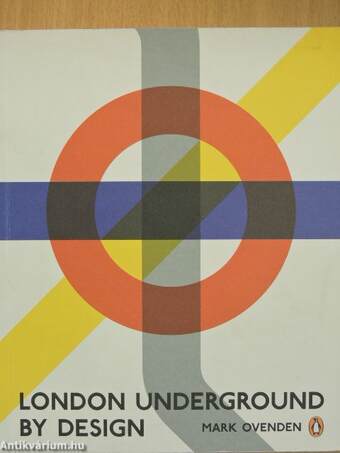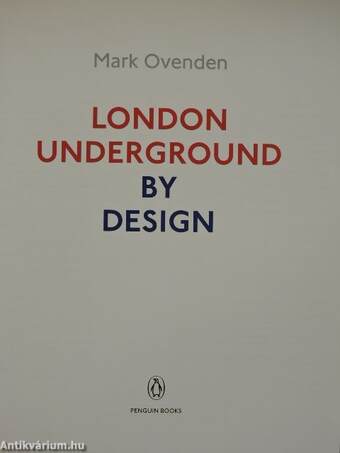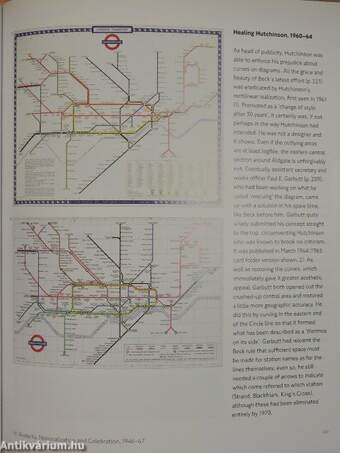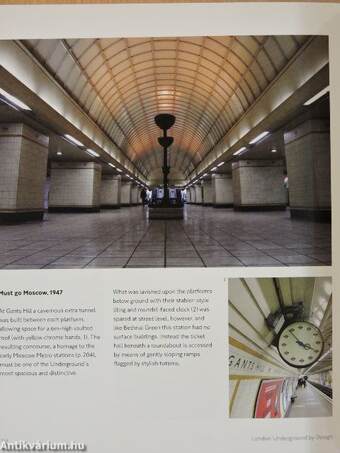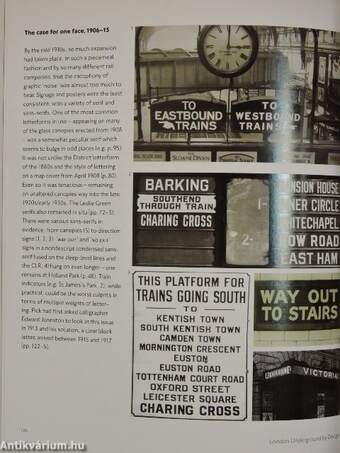1.063.261
kiadvánnyal nyújtjuk Magyarország legnagyobb antikvár könyv-kínálatát

VISSZA
A TETEJÉRE
JAVASLATOKÉszre-
vételek
London Underground by Design
| Kiadó: | Penguin Group |
|---|---|
| Kiadás helye: | New York |
| Kiadás éve: | |
| Kötés típusa: | Fűzött papírkötés |
| Oldalszám: | 288 oldal |
| Sorozatcím: | Penguin Books |
| Kötetszám: | |
| Nyelv: | Angol |
| Méret: | 22 cm x 19 cm |
| ISBN: | 978-1-846-14417-2 |
| Megjegyzés: | Színes és fekete-fehér fotókkal. |
naponta értesítjük a beérkező friss
kiadványokról
naponta értesítjük a beérkező friss
kiadványokról
Előszó
TovábbFülszöveg
A beautifully illustrated and comprehensive history of one of the world's most celebrated design achievements, and of the visionaries who brought it to life.
Since its establishment 150 years ago as the world's first urban subway, the London Underground has continuously set a bench-mark for design that has influenced transit systems from New York to Tokyo, Moscow to Paris and beyond. London underground by design is the first meticulous study of every aspect of that feat.
Beginning in the pioneering Victorian age, Mark Ovenden charts the evolution of architecture, branding, typeface, map design, interior and textile styles, posters, signage and graphic design and how these came together to shape not just the Underground's identity, but the character of London itself. This is the story of celebrated designers - from Frank Pick, the guru who conceptualised the modern Tube's look under the 'design fit for purpose' mantra, to Harry Beck, Tube diagram creator, and from Marion Dorn,... Tovább
Fülszöveg
A beautifully illustrated and comprehensive history of one of the world's most celebrated design achievements, and of the visionaries who brought it to life.
Since its establishment 150 years ago as the world's first urban subway, the London Underground has continuously set a bench-mark for design that has influenced transit systems from New York to Tokyo, Moscow to Paris and beyond. London underground by design is the first meticulous study of every aspect of that feat.
Beginning in the pioneering Victorian age, Mark Ovenden charts the evolution of architecture, branding, typeface, map design, interior and textile styles, posters, signage and graphic design and how these came together to shape not just the Underground's identity, but the character of London itself. This is the story of celebrated designers - from Frank Pick, the guru who conceptualised the modern Tube's look under the 'design fit for purpose' mantra, to Harry Beck, Tube diagram creator, and from Marion Dorn, one of the twentieth-century's leading textile designers, to Edward Johnston,
creator of the distinctive font that bears his name, as well as Leslie Green, designer of central London's distinctive ruby-red tiled stations, and the Design Research Unit's head, Misha Black, who in the 1960s rebranded British Railways and created the Victoria line's distinctive style, and Sir Norman Foster, architect of Canary Wharf station.
Rich with hundreds of illust- ^fl rations, some never seen before,
LONDON UNDERGROUND BY DESIGN
shows that design is not just about aesthetic pk^sure, but is crucial to how we get around. Vissza
Témakörök
- Idegennyelv > Idegennyelvű könyvek > Angol > Műszaki
- Idegennyelv > Idegennyelvű könyvek > Angol > Művészetek > Építészet
- Idegennyelv > Idegennyelvű könyvek > Angol > Művészetek > Iparművészet
- Műszaki > Ipar > Építőipar > Szakipari munkák
- Művészetek > Építészet > Kontinensek szerint > Európa > Angol
- Művészetek > Építészet > Idegen nyelv > Angol
- Művészetek > Építészet > Épületek > Ipari > Állomások
- Műszaki > Ipar > Építőipar > Tervezés
- Művészetek > Iparművészet > Formatervezés > Design
- Művészetek > Iparművészet > Idegen nyelv > Angol
- Műszaki > Idegennyelv > Angol
- Műszaki
- Műszaki > Közlekedés
- Műszaki > Közlekedés > Vasút > Egyéb
Mark Ovenden
Mark Ovenden műveinek az Antikvarium.hu-n kapható vagy előjegyezhető listáját itt tekintheti meg: Mark Ovenden könyvek, művekMegvásárolható példányok
Nincs megvásárolható példány
A könyv összes megrendelhető példánya elfogyott. Ha kívánja, előjegyezheti a könyvet, és amint a könyv egy újabb példánya elérhető lesz, értesítjük.



